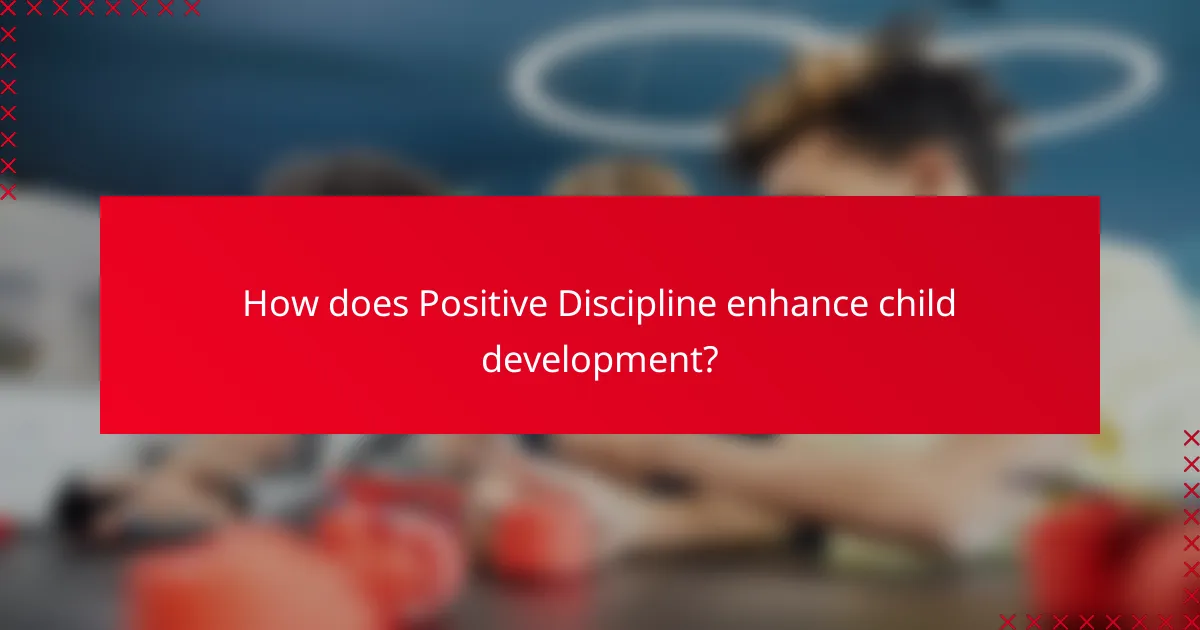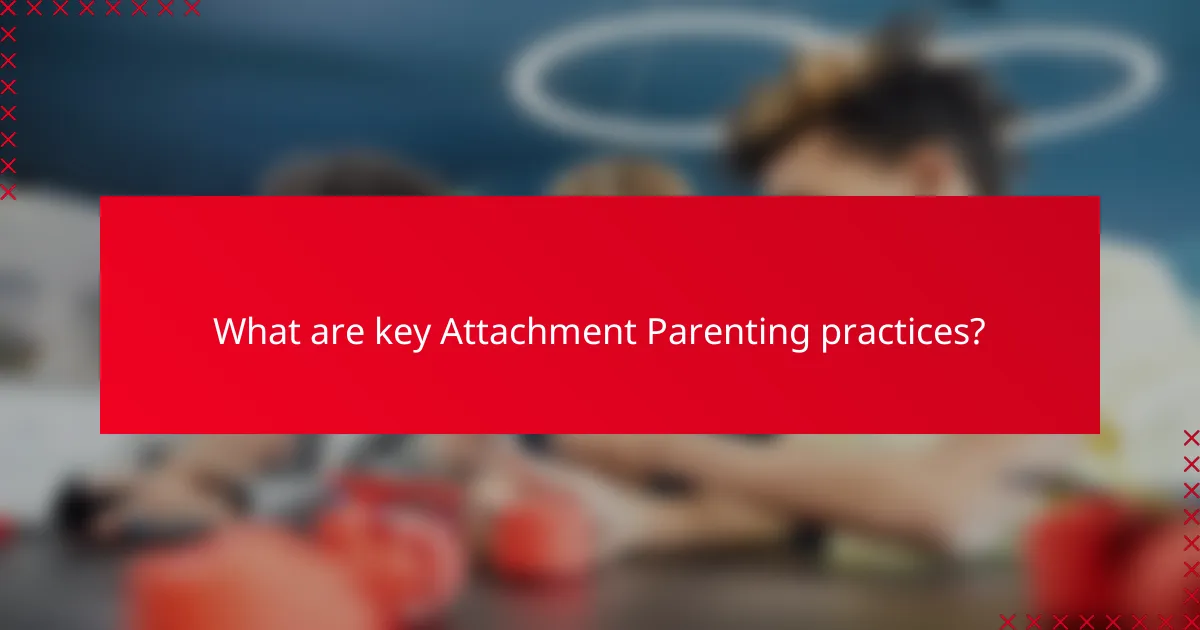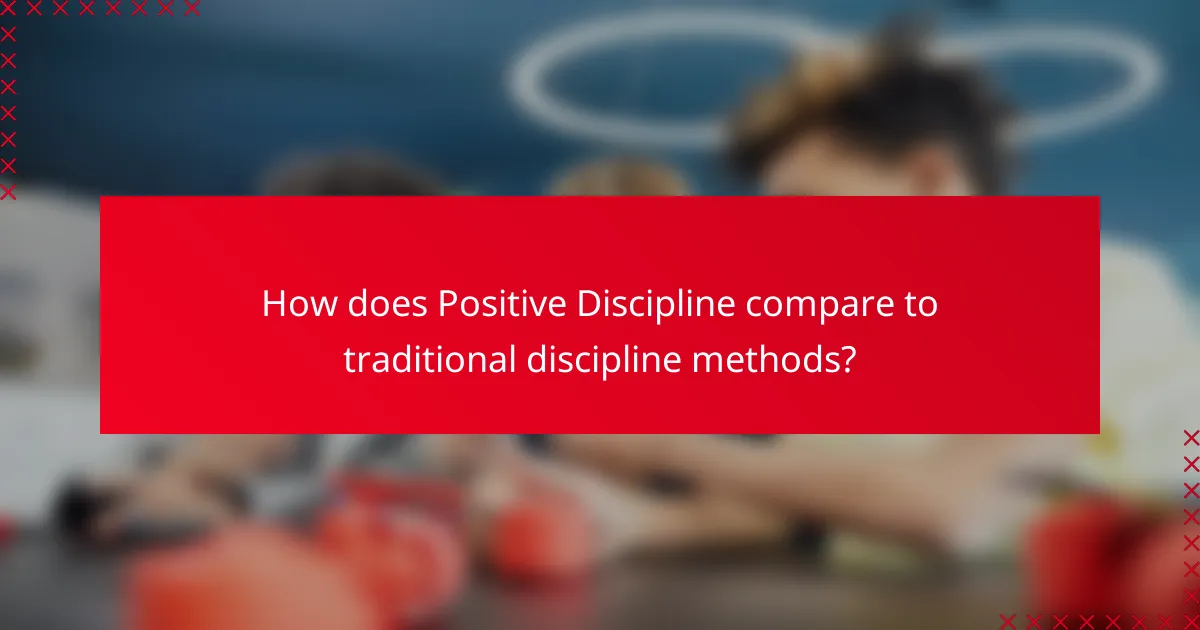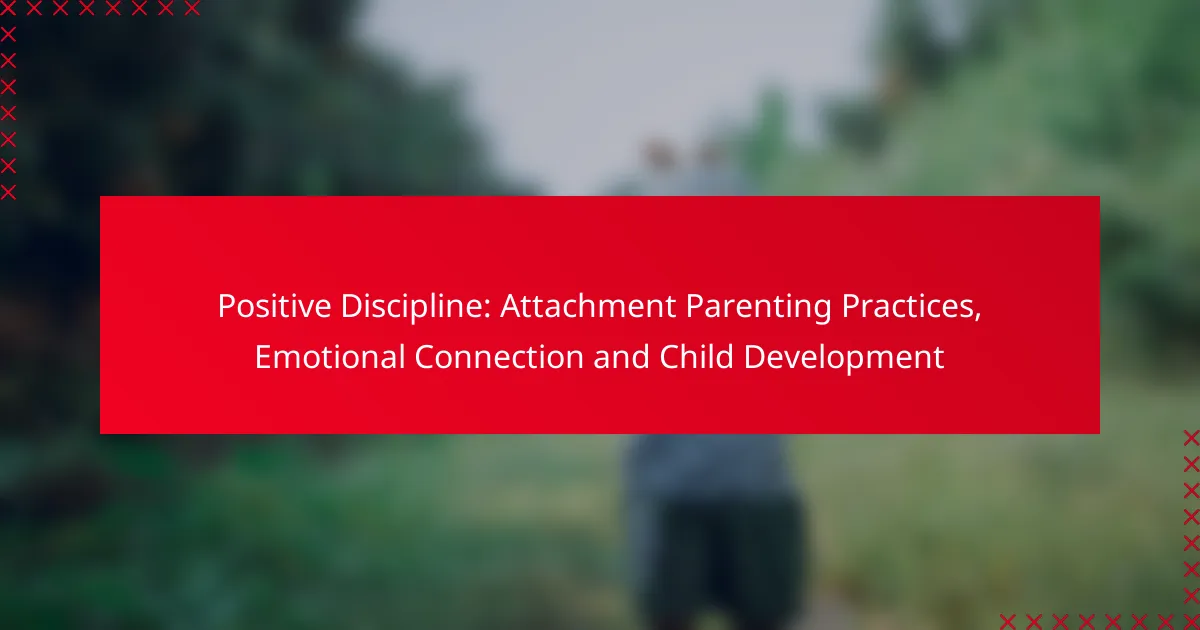Positive Discipline is an effective approach that enhances child development by creating a nurturing environment that prioritizes emotional growth and social skills. By integrating key Attachment Parenting practices, it fosters strong emotional bonds through responsive interactions, ultimately promoting self-discipline, responsibility, and respect in children.

How does Positive Discipline enhance child development?
Positive Discipline enhances child development by fostering a nurturing environment that promotes emotional growth and social skills. This approach focuses on teaching children self-discipline, responsibility, and respect through supportive interactions rather than punitive measures.
Promotes emotional intelligence
Positive Discipline encourages children to recognize and understand their own emotions as well as the feelings of others. By engaging in open discussions about feelings and providing a safe space for expression, parents can help children develop empathy and emotional regulation.
For example, when a child experiences frustration, a parent can validate those feelings and guide them in expressing their emotions constructively. This practice not only enhances emotional awareness but also strengthens interpersonal relationships.
Fosters secure attachments
Secure attachments are crucial for healthy child development, and Positive Discipline plays a significant role in establishing these bonds. By consistently responding to a child’s needs with warmth and understanding, parents can create a trusting environment that fosters emotional security.
Activities such as shared playtime and active listening can deepen the parent-child connection. Children who feel securely attached are more likely to explore their environment confidently, knowing they have a safe base to return to.
Encourages problem-solving skills
Positive Discipline empowers children to become effective problem solvers by involving them in discussions about challenges they face. Instead of providing immediate solutions, parents can guide children to brainstorm possible outcomes and evaluate their choices.
This approach not only builds critical thinking skills but also instills a sense of ownership in the decision-making process. For instance, when faced with a conflict, parents can ask, “What do you think we can do to resolve this?” This encourages children to think creatively and collaboratively.
Builds resilience in children
Resilience is the ability to bounce back from setbacks, and Positive Discipline helps cultivate this trait in children. By allowing children to experience natural consequences in a supportive environment, parents can teach them how to cope with failure and learn from their mistakes.
For example, if a child forgets their homework, instead of rushing to their aid, a parent might let them face the consequences at school. This experience can help the child develop strategies for better organization in the future, reinforcing their ability to handle challenges independently.

What are key Attachment Parenting practices?
Key Attachment Parenting practices focus on fostering a strong emotional bond between parent and child through responsive and nurturing interactions. These practices emphasize understanding and meeting a child’s needs to promote healthy development and emotional well-being.
Responsive parenting techniques
Responsive parenting techniques involve recognizing and promptly addressing a child’s cues and signals. This can include responding to a baby’s cries with comfort or engaging in play when a child shows interest. The goal is to create a secure environment where children feel valued and understood.
To implement responsive techniques, parents can practice active listening and observe their child’s behavior closely. For instance, when a toddler expresses frustration, acknowledging their feelings and offering assistance can help them feel supported and connected.
Consistent emotional support
Consistent emotional support is crucial for building a child’s self-esteem and emotional resilience. This involves regularly providing reassurance, encouragement, and validation of their feelings. Children thrive when they know they can rely on their parents for emotional stability.
Parents can foster emotional support by establishing routines that include quality time together, such as reading at bedtime or discussing the day’s events. These practices help children feel secure and understood, reinforcing their emotional connection with caregivers.
Physical closeness and bonding
Physical closeness and bonding are essential components of Attachment Parenting, promoting a sense of safety and trust. Activities like holding, cuddling, and gentle touch can strengthen the parent-child bond and enhance emotional development.
To encourage physical closeness, parents can incorporate practices like babywearing or co-sleeping, which allow for increased contact and comfort. These practices not only help in soothing the child but also foster a deeper emotional connection that can last into later childhood.

How can Positive Discipline be implemented in daily life?
Positive Discipline can be integrated into daily routines by establishing a nurturing environment that emphasizes respect, understanding, and guidance. This approach fosters emotional connections and supports healthy child development through consistent practices.
Setting clear expectations
Establishing clear expectations is essential for effective positive discipline. Communicate rules and boundaries in a straightforward manner, ensuring that children understand what is expected of them. For example, instead of saying “be good,” specify “please use your indoor voice while we are inside.”
Involve children in the process by discussing the reasons behind rules. This not only helps them comprehend the importance of guidelines but also encourages them to take ownership of their behavior. Regularly revisiting these expectations can reinforce their understanding.
Using positive reinforcement
Positive reinforcement involves acknowledging and rewarding desirable behaviors to encourage their recurrence. Simple methods include verbal praise, stickers, or extra playtime when a child follows rules or displays kindness. This approach motivates children to repeat positive actions.
Consider implementing a reward system where children can earn points for good behavior, which they can later exchange for small privileges or treats. This not only reinforces positive behavior but also teaches them about delayed gratification.
Modeling appropriate behavior
Children learn by observing their caregivers, making it crucial to model appropriate behavior consistently. Demonstrate respect, empathy, and problem-solving skills in your daily interactions. For instance, when faced with a challenge, verbalize your thought process to show how to handle difficulties constructively.
Engage in role-playing scenarios with your child to practice responses to various situations. This not only builds their emotional intelligence but also provides them with practical tools for managing their own behavior in real-life contexts.

What role does emotional connection play in parenting?
Emotional connection is crucial in parenting as it fosters trust and security in children, which are essential for their overall development. A strong emotional bond enables parents to understand their child’s needs better and respond appropriately, promoting healthy growth and resilience.
Strengthens parent-child relationships
A strong emotional connection enhances the parent-child relationship by creating a safe environment for children to express themselves. When parents are emotionally available, children feel valued and understood, which strengthens their attachment and promotes positive behaviors.
To nurture this bond, parents can engage in activities that encourage closeness, such as reading together, playing games, or simply spending quality time. Consistent, loving interactions help solidify trust, making children more likely to seek guidance and support from their parents.
Enhances communication skills
Emotional connection significantly enhances communication skills between parents and children. When children feel emotionally secure, they are more likely to share their thoughts and feelings openly, leading to better understanding and cooperation.
Parents can improve communication by actively listening and validating their child’s emotions. Techniques such as using open-ended questions and reflecting back what the child says can further encourage dialogue. This practice not only builds emotional intelligence but also equips children with essential skills for effective communication in their future relationships.

What are the benefits of Positive Discipline in urban settings?
Positive Discipline fosters emotional connections and promotes healthy child development, particularly in urban environments where families face unique challenges. It emphasizes respectful communication and understanding, which can lead to better behavior and stronger relationships between parents and children.
Adapts to diverse family structures
Positive Discipline is flexible and can be tailored to fit various family dynamics, including single-parent households, blended families, and extended family arrangements. This adaptability allows caregivers to implement strategies that resonate with their specific situations, ensuring that discipline is effective and supportive.
For example, a single parent might focus on establishing consistent routines while a blended family may prioritize open discussions to address differing parenting styles. This approach helps maintain harmony and respect among family members.
Addresses challenges in high-stress environments
Urban settings often come with heightened stress due to factors like noise, crowded living conditions, and busy schedules. Positive Discipline provides tools for managing these stresses by promoting calm and constructive interactions between parents and children. Techniques such as active listening and empathy can help de-escalate conflicts.
Parents can benefit from setting aside dedicated time for one-on-one interactions, even if brief, to strengthen their emotional connection. Simple activities like reading together or discussing the day can significantly enhance the parent-child bond, making it easier to navigate stressful situations.

How does Positive Discipline compare to traditional discipline methods?
Positive Discipline emphasizes teaching children self-discipline through understanding and connection, contrasting sharply with traditional methods that often rely on punishment and control. This approach fosters a supportive environment that nurtures emotional growth and strengthens parent-child relationships.
Focuses on understanding behavior
Positive Discipline prioritizes understanding the reasons behind a child’s behavior rather than simply reacting to it. By observing and interpreting a child’s actions, parents can identify underlying needs or emotions, which helps in addressing the root causes of misbehavior.
For instance, if a child is acting out due to frustration, a positive discipline approach would involve discussing their feelings and finding constructive solutions together. This method not only resolves immediate issues but also teaches children valuable emotional regulation skills.
Reduces reliance on punishment
Unlike traditional discipline, which often resorts to punitive measures, Positive Discipline seeks to minimize punishment by promoting mutual respect and cooperation. This approach encourages parents to use natural consequences and problem-solving techniques instead of imposing arbitrary penalties.
For example, if a child refuses to do their homework, instead of punishment, a parent might discuss the importance of responsibility and help the child create a manageable schedule. This fosters accountability and reinforces the child’s intrinsic motivation to learn.
